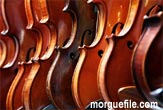Legendary Violins Were Chemically Treated

The stirring sounds of two legendary types of violin have haunted musicians and baffled craftsmen for centuries.? Now, a researcher claims he is one note closer to recreating the secret recipe that produced the famous Stradivarius and Guarneri instruments.
Some have suggested that the celebrated Italian violin makers, Stradivari and Guarneri del Ges?, used chemically treated wood to create their instruments, which possess some of the most brilliant resonances ever heard with a stringed instrument.
Testing this hypothesis hasn't been easy, however. Only about 650 Strads and 150 Guarneri violins are known to have survived, making sample collection a challenge.
Joseph Nagyvary, a researcher at Texas A&M University devoted to recreating old Stradivarius and Guarneri violins, waited 21 years to gather enough small shavings for analysis.
A chemical dousing
Nagyvary and colleagues tested the organic matter in samples taken from inside five antique violins during repair. They found strong evidence that the wood used by these masters were chemically treated.
"The instruments were a violin by Stradivari, dated 1717; a cello by Stradivari (1731); a violin by Guarneri del Ges? (1741); a violin by Gand-Bernardel of Paris (1840s); and a viola by Henry Jay of London (1769)," the researchers write in the Nov. 30 issue of the journal Nature. ?They compared the violin shavings to recent tone woods from Bosnia and central Europe.
Get the world’s most fascinating discoveries delivered straight to your inbox.
They analysis revealed that the Cremonese masters chemically treated their wood in ways not done by their colleagues in Paris or London, nor by modern violin makers.
The chemical treatment might have initially been performed for other purposes, but then found to have the added bonus of enhancing the instruments' acoustical qualities.
"It's logical to assume that they wanted to kill the woodworm and preserve the wood against fungi," Nagyvary told LiveScience.com.
Understanding the chemistry of this process, which is still only hypothesized, could lead to improvements in the production of modern violins.
One can make only educated guesses that oxidizing agents and boiling in water were used to treat the maple used to make these violins, Nagyvary said.
Controversial beauty
The effort that Nagyvary is putting into this endeavor pleases many instrumentalists devoted to the designer violins and could even change the practice of violin-making forever. However, some believe that in terms of sound it could be a futile undertaking.
"I played a Strad for some time," said Christopher Whiting, a professional violinist and a writer for Strings Magazine.? "Now I have daily contact with a Guarneri del Ges?. I don't believe that expensive old violins sound better than good modern violins. I have never been able to hear the difference when doing a 'blind test,' listening to several violins, one after the other, without looking to see which one is being played. Nobody I've met has been able to do it either. But it's easy to tell the difference between a good violinist and a bad violinist!"
Stradivari's violins have also changed significantly since he made them more than 250 years ago. The length of the instruments' neck, their inclination, bridge, bass bar, their strings and overall tension, as well as the music played on them, have all been altered as a result of passing time and changing tastes.
"I'm not sure he would like the way they sound now," Whiting told LiveScience.com. ?"Stradivari didn't build his instruments so that a violinist playing the Brahms violin concerto can be heard in a 2,500 seat auditorium over an entire symphony orchestra. The music of Corelli was the style of his day. If we could put Antonio Stradivari in the audience today and ask him if that is his violin being played, he would certainly say no, he doesn't recognize it."
No one knows if the beauty of these instruments lies in their sound, physical structure, scarcity, or a combination unified in a string theory that will forever mystify music lovers. Or perhaps they are a reminder of an era long gone and music forgotten by many.?
"Those old violins have a significance unrelated to their sound in concert," Whiting said.? They are beautiful to look at and have served as models for many generations of great violin makers who have come after them.
- Why Music Gives Us the Chills
- Music Tickles Strong Memories
- XPod Would Sense Your Emotions Then Pick Music
- Study: Why Americans Have Bad Rhythm
???????????????????????????????????????????????????????????????



